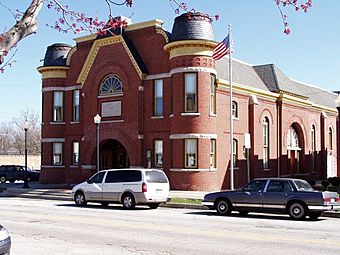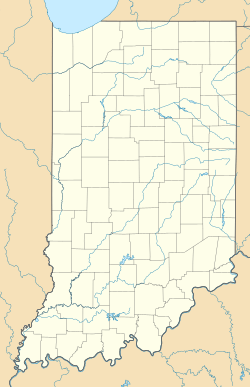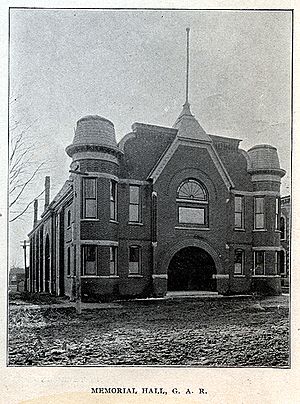Porter County Memorial Opera Hall facts for kids
Quick facts for kids |
|
|
Porter County Memorial Hall
|
|

Porter County Memorial Hall in 2004
|
|
| Location | 104 Indiana Ave., Valparaiso, Indiana |
|---|---|
| Area | less than one acre |
| Built | 1893 |
| Architect | Lembke, Charles F. |
| Architectural style | Queen Anne |
| NRHP reference No. | 84001231 |
| Added to NRHP | May 23, 1984 |
The Porter County Memorial Hall, also known as the Memorial Opera House, is a historic building in Valparaiso, Indiana. It was built a long time ago as a special meeting place for a group called the Grand Army of the Republic (GAR). This group was made up of soldiers who fought in the American Civil War.
The building was designed in 1892 by a local architect named Charles F. Lembke. It was finished in 1893. It was built to hold about 100 people. Besides being a meeting hall for the GAR, it was also used as the local opera house, where people could watch plays and performances.
Many famous people have visited the Memorial Opera House. It is said that William Jennings Bryan, a well-known politician, spoke there during his presidential campaign in 1896. Other famous visitors included Theodore Roosevelt, who later became president, and the famous bandleader John Phillips Sousa. Even the funny Marx Brothers performed there!
Over time, movies became popular, and fewer people came to live shows. The building was even changed to show movies. By the time of World War II, the Memorial Opera House was almost empty.
In 1955, a group called the Community Theatre Guild started using the building. They began fixing it up for theater shows again. Porter County took full control of the building in the late 1990s. They did a big renovation to make it look new again. Today, the building is still used for plays and other community events, just as it was meant to be.
The Memorial Opera House is located at 104 Indiana Avenue. It is just east of the historic Porter County Jail and Sheriff's House. When it was first built, Indiana Avenue was called Mechanics Street. The Opera House was added to the National Register of Historic Places in 1984. This means it is a very important historic site.
Today, the Memorial Theatre Company puts on about six plays each year. They also host concerts and other fun events for the community.
Contents
Building Style and Outside Look
The Memorial Opera House was built in 1893. Its design is called "eclectic" because it mixes different styles. It has many features of the Queen Anne style, like its detailed decorations and balanced look. You can also see influences from famous architects like Louis Sullivan and H. H. Richardson, who worked in nearby Chicago.
Main Entrance and Front Details
The front of the building has a part that sticks out, which is two stories tall. This section has a special roof shape called a "jerkin-head gable." The main entrance on the ground floor has a wide, rounded arch made of brick and stone.
The main doors are made of two pairs of doors with many small windows. Above the doors, there are eight glass sections that spread out like a fan.
Above the entrance, there is a stone panel with an important message. It says: "1883, Memorial Hall, A monument to the Soldiers and Sailors of 1861-5." This shows that the building is a tribute to the soldiers and sailors of the Civil War. Above this stone, there is another fan-shaped window with clear and stained glass.
Side Features and Towers
On both sides of the main entrance, there are single window sections. The windows on the ground floor are arched and can be opened from both the top and bottom. The windows above them also have stone sills.
Two round towers stand on either side of the main front of the building. These towers have rectangular windows with decorative brickwork above them. The building has a sloped roof, with smaller sloped roofs over parts that stick out. There are also arched windows on each side of the building, similar to the front.
Inside the Opera House
The inside of the Memorial Opera House still has its original orchestra pit. This is where musicians play music during a show. It also has special side boxes, which are small private seating areas. These boxes are decorated with carved posts and railings.
In 1967, the building got a new floor and modern seating. The orchestra pit was also improved. These updates cost about $250,000 at the time.
Why This Building Is Important
The idea for the Memorial Hall came from the Chaplain Brown Post of the Grand Army of the Republic. They wanted to build a place to honor Civil War soldiers. They raised money from the public to help build it. The county leaders also gave land and more money.
When it opened in 1893, the G.A.R. used the building for patriotic events, concerts, and talks. However, they had trouble paying for the building's costs. So, in 1901, the county took over the building and its debts.
A Place for Entertainment and Speeches
In 1901, the building was leased to Albert F. Heineman. He brought in many different kinds of entertainment. This included traveling theater groups, political speakers, and vaudeville shows. It is believed that William Jennings Bryan gave his famous "Cross of Gold and Crown of Thorns" speech there. Theodore Roosevelt also visited in 1900 while campaigning for William McKinley.
Live performances were very popular at the Opera House until the 1920s. Then, movies started to become more popular. During the 1920s, 1930s, and 1940s, the Opera House showed some films and hosted local performances. But it was often empty.
Saving the Opera House
By the 1950s, people were even thinking about tearing the building down. But in 1957, the Community Theatre Guild was formed. Their main goal was to fix up and save the Opera House.
The Guild made a deal with the county to lease the building. They started making repairs and creating a stage for local actors. A big renovation project happened in 1967, costing $250,000. The Guild continued to use the Opera House until the mid-1990s. At that time, the county started a huge renovation project that cost millions of dollars.
The Memorial Opera House is a great example of buildings from the 1890s. It has stayed in amazing condition, showing us what these kinds of places looked like during the Victorian era.
Images for kids











